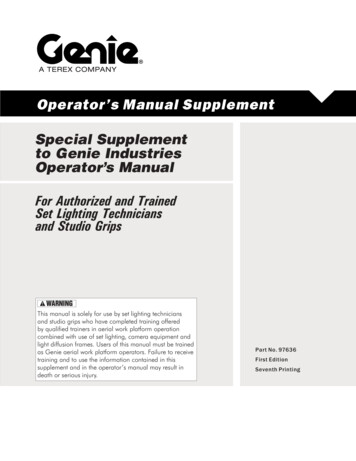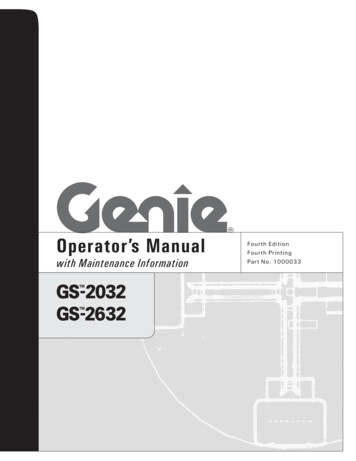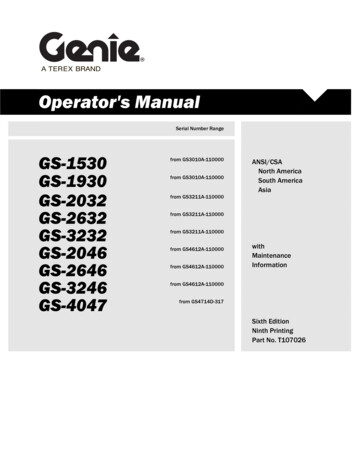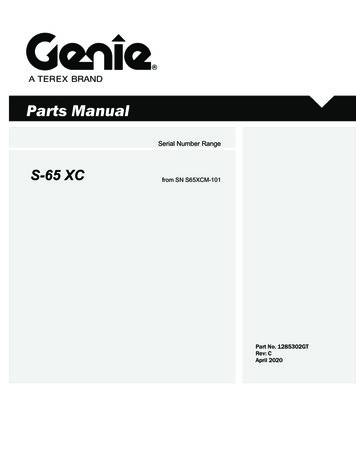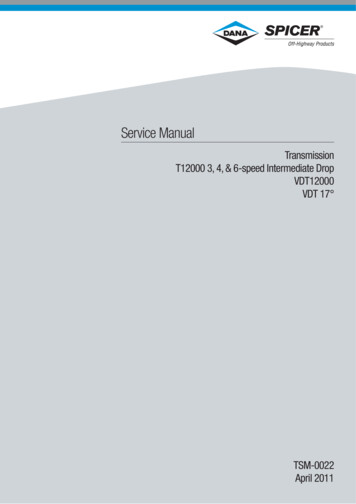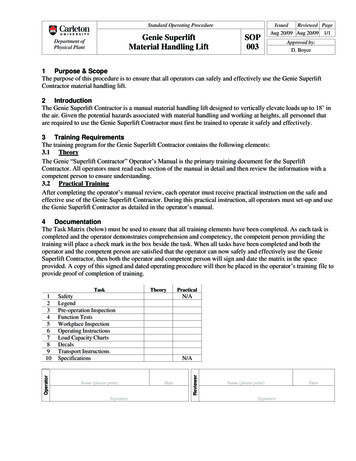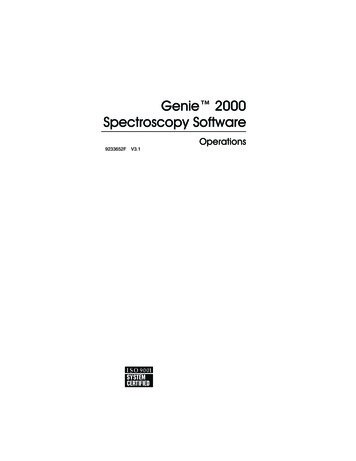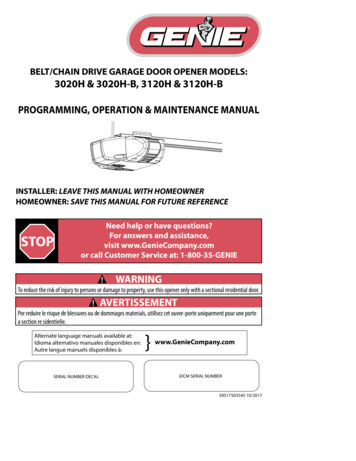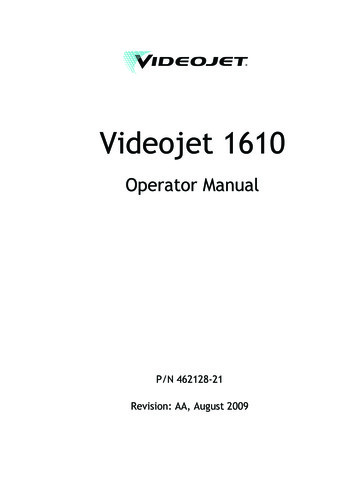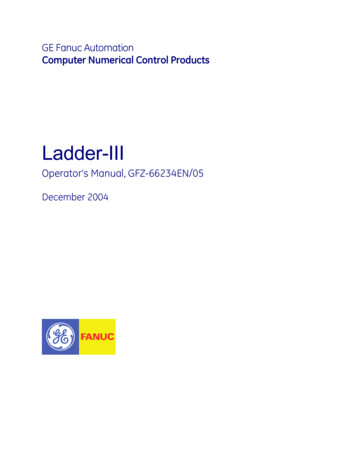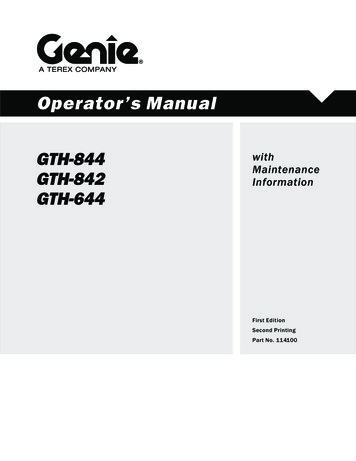
Transcription
Operator’s ionFirst EditionSecond PrintingPart No. 114100
TABLE OF CONTENTSSECTION 1ROUGH TERRAIN FORK LIFT SAFETY SECTIONIntroductionStandards And SymbolsSafetyTraining And KnowledgeOperator's ResponsibilitiesManagement's ResponsibilitiesMaintenance And RepairOperation Safety1-11-31-41-51-51-61-71-81-9SECTION 2GENERAL SAFETYGeneral Safety ProceduresJump StartingProper Load Chart Use2-12-32-82-9SECTION 3CONTROLS AND INSTRUMENTSOperator's CompartmentJoystick Control FunctionsJoystick Control Functions (Button Pushed)Service BrakesLow Service Brake Pressure LightParking BrakeFrame Sway ControlGaugesHydraulic Pump Destroke ButtonSteeringTransmissionFront Axle Differential ION 4OPERATIONOperation And Safety GuidelinesBefore Starting The EngineStarting The EngineBefore Operating The ForkliftTransporting A LoadPlacing A Load4-14-34-44-54-74-114-13SECTION 5MAINTENANCE PROCEDURESGeneral Safety PracticesDaily Maintenance5-15-35-5SECTION 6MATERIAL SAFETY DATAMaterial Safety Data SheetsCalifornia Proposition 65 Warnings6-16-36-4
SECTION 1ROUGH TERRAINFORK LIFT SAFETY1-1
TABLE OF CONTENTSSECTION 1 - ROUGH TERRAIN FORK LIFT SAFETYIntroduction1-3Standards And Symbols1-4Safety1-5Training And Knowledge1-5Operator's Responsibilities1-6Management's Responsibilities1-7Maintenance And Repair1-8Operation Safety1-91-2
ROUGH TERRAIN FORK LIFT SAFETYINTRODUCTIONOwners, Users, and Operators:Genie appreciates your choice of our machine for your application. Our number onepriority is user safety, which is best achieved by our joint efforts. We feel that you make amajor contribution to safety if you, as the equipment users and operators:1. Comply with OSHA, Federal, State, and Local Regulations.2. Read, Understand, and Follow the instructions in this and other manualssupplied with this machine.3. Use Good Safe Work Practices in a common sense way.4. Only have trained/certified operators – directed by informed andknowledgeable supervision – running the machine.NOTE: OSHA prohibits the alteration or modification of this machine without writtenmanufacturer's approval. Use only factory approved parts to service or repair thismachine.If there is anything in this manual that is not clear or which you believe should be added,please contact us.Internet: www.genieind.comEmail: techpub@genieind.comThank you!THIS SYMBOL MEANS YOUR SAFETY ISINVOLVED! READ, UNDERSTAND ANDFOLLOW ALL DANGER, WARNING ANDCAUTION DECALS ON YOUR ROUGH TERRAINFORKLIFT.1-3
ROUGH TERRAIN FORK LIFT SAFETYSTANDARDS AND SYMBOLSSTANDARDSMany aspects of rough terrain forklift operation and testing are discussed in standardspublished by the American National Standards Institute. These Standards are updated ona regular basis with addendas. Genie recommends that you purchase and refer to thefollowing standards.ANSI B56.6 – Rough Terrain Fork LiftsThis Standard can be purchased from:American National Standards Institute25 West 43nd Street, 4th Fl.New York, New York, 10036Tel. 212.642.4900Fax. 212.398.0023SYMBOLSThe symbols below are used to inform the operator of important information concerningthe operation of this machine.DANGER – Indicates an imminently hazardous situationwhich, if not avoided, will result in death or serious injury.WARNING – Indicates a potentially hazardous situationwhich, if not avoided, could result in death or seriousinjury.CAUTION – Indicates a potentially hazardous situationwhich, if not avoided, may result in minor or moderateinjury.ATTENTION – Indicates a situation which, if not avoided,may result in property or equipment damage.1-4
ROUGH TERRAIN FORK LIFT SAFETYSAFETYThese are general safety rules, which must be followed. You are also required to readand understand the Operator's Manual as there are instructions, which are moredetailed specific to this machine.TRAINING AND KNOWLEDGE1. Safety must always be the operator's most important concern.2. This machine must only be operated by trained personnel, who have demonstratedtheir ability to do so safely.3. Comply with the requirements of current Occupational Safety and HealthAdministration (OSHA) standards, including 29CFR1910.178; and the AmericanNational Standards Institute (ANSI) B56.6 latest edition.4. Read and Understand all Decals and Warnings.5. Read and Understand the Rating Chart.6. Know that the machine can safety lift each load before attempting to lift.1-5
ROUGH TERRAIN FORK LIFT SAFETYOPERATOR'S RESPONSIBILITIES1. Read and understand the Operator’s Manual.2. Know the location and the purpose of the controls, instruments and indicatorlights.3. Make sure the machine is in proper order and all operational aids and warningsignals are functional before operating.4. Keep the machine clean, including all instrumentation, windows, lights and otherglazed surfaces.5. Use protective clothing and safety equipment. Always use approved safetyequipment such as: gloves, safety boots, hard hats, safety glasses and earprotection where necessary.6. Wear protective clothing that is snug and belted where required.7. Store tools and other necessary items in the toolbox.8. Never lift a load without a Load Rating Chart in the cab.9. Know the load to be lifted.10. Be alert, physically fit and free from the influences of alcohol, drugs ormedications that might affect the operator’s eyesight, hearing, or reactions.11. Keep people, equipment and material out of the work area.12. Keep a fully charged fire extinguisher and first aid kit in the cab at all times, andbe familiar with how to use these items.13. Know about movements of other machinery, trucks and personnel at the jobsite.14. Make sure everyone is in a safe place before moving the boom, forks, load oroutriggers (if so equipped.)15. Start and stop movements smoothly and swing at speeds that will keep the loadunder control.1-6
ROUGH TERRAIN FORK LIFT SAFETYMANAGEMENT'S RESPONSIBILITIES1. Ensure operators are competent, physically fit, trained and if required licensed.2. Have a supervisor at the job site to be responsible for job safety.3. Crew members given specific safety responsibilities and instructed to report anyunsafe conditions to the supervisor.4. Supply the weight on the load to be lifted to the operator.5. Verify that all crewmembers are familiar with OSHA, ANSI B56.6 requirementsas well as instructions in the manuals.1-7
ROUGH TERRAIN FORK LIFT SAFETYMAINTENANCE AND REPAIR1. Practice safe maintenance procedures. Perform all maintenance and repairs inaccordance with instructions provided by the manufacturer in the manuals. Alsoheed the warnings on the placards and decals on the machine.2. Always use supports and braces when working on, under or around the machineor forks.3. Shut off the engine and lockout the machine while working on the machine unlessinstructions specifically require the engine to be running.4. Always make sure the machine is stationary prior to performing adjustments orlubrication.5. Replace all shields and guards after performing service.6. Always use a piece of cardboard or paper to search for leaks.7. When performing work on the hydraulic system:i.ii.iii.iv.v.vi.Lower the boom to horizontal.Support the boom with supports or braces.Shut down the engine.Relieve all pressure before disconnecting lines.Ensure all connections are tight before applying pressure.Repair or replace any damaged line, hose or fitting beforeapplying pressure.8. Always have tires serviced and mounted by a qualified person with the propertools and guards.9. Always use an inflation cage during tire inflation.10. Only perform welding on the machine with approval from the manufacturer.1-8
ROUGH TERRAIN FORK LIFT SAFETYOPERATION SAFETY1. Always inspect the machine daily. Check for leaks, worn hoses, loose belts,broken structures, and loose or missing bolts. Repair or replace any worn,damaged or leaking parts prior to operation of the machine.2. Only inspect the coolant level when the engine and coolant are cool.3. Be sure that all guards and screens are secure and in the proper place.4. Inspect for and clear the work area of any obstructions that could interfere withproper machine operation. Any obstructions that cannot be cleared should beclearly marked and avoided during operation.5. Refueling:i. Always stop the engine before refueling the machine.ii. Fill the fuel tank outdoors.iii. Handle fuel with care, as it is highly flammable. Do not refuelthe machine while smoking or near open flames.iv. Always clean up spilled fuel.6. Make sure the machine and access system is clean and free of dirt, oil, grease ordebris.7. When getting on and off the machine, face the machine, use the steps andhandrails provided, and always maintain a three point contact.8. Always remain completely inside the cab enclosure while operating the machine.9. Always wear the seat belt while operating the machine.10. Always completely lower the boom with the forks resting on the ground beforeany work is performed on or around the machine.11. Do not operate the machine while people are under or near an elevated boomwhether the boom is loaded or unloaded. Falling objects from the forks orattachment may cause serious injury or death.1-9
ROUGH TERRAIN FORK LIFT SAFETYOPERATION SAFETY12. Maintain an appropriate clearance from electrical power lines. See the chartbelow for minimum safe approach distances.Minimum Safe Approach DistancePower Line VoltageRequired Clearance0 to 50 kV10 ft. (3.00 m)50 to 200 kV15 ft. (4.60 m)200 to 350 kV20 ft. (6.10 m)350 to 500 kV25 ft. (7.62 m)500 to 750 kV35 ft. (10.67 m)750 to 1000 kV45 ft. (13.72 m)13. Lifting Loads:i. Using the load chart, confirm that the load is within the ratedcapacity of the machine for the required configuration.ii. Level the machine using the level gauge before lifting loads. Usethe sway control to level the machine only when the boom is athorizontal or lower. Using the sway control with the boom abovehorizontal may cause the machine to overturn.iii. Verify that the load is secured on the forks before performing a lift.Rearrange the load if necessary.iv. Before lowering a maximum load, always retract the boomcompletely.v. Use proper attachments, such as a truss boom, to lift suspendedloads.14. If the load to be lifted exceeds the capacity of the machine for the givenconfiguration:i. Move the machine closer to the load so that the weight of the loadwill be within the allowable load chart specifications.ii. Divide the load into smaller pieces.iii. Get a larger machine capable of handling the load.15. Always move a load so that you have maximum machine stability and visibility isnot obstructed. Keep the boom at or below horizontal, with the load close to theground.16. Tilt the forks back towards the machine slightly during travel to ensure stability ofthe load.1 - 10
ROUGH TERRAIN FORK LIFT SAFETYOPERATION SAFETY17. Inspect the path of travel before beginning movement. Avoid holes and dropoffs.18. Traveling on slopes/grades.i. Ascend and descend slowly and with caution.ii. When loaded, always travel with the load uphill.iii. When unloaded,travel with the attachment downhill.iv. Avoid turning, travel straight up and down.19. Always position all wheels in line with the machine before switching the steeringmode.20. Always position the machine and set the park brake before lifting a load.21. Do not allow riders on the machine or forks.22. Do not transport or lift personnel into position with this forklift.23. When leaving the operator's station:i. Place the directional controls in neutral.ii. Apply the parking brake.iii. Lower the attachment to the ground.1 - 11
ROUGH TERRAIN FORK LIFT SAFETYNOTES1 - 12
SECTION 2GENERAL SAFETY2-1
TABLE OF CONTENTSSECTION 2 - GENERAL SAFETYGeneral Safety Procedures2-3Jump Starting2-8Proper Load Chart Use2-92-2
GENERAL SAFETYGENERAL SAFETY PROCEDURESSAFETY ALERT SYMBOLStop and take time to read ALL safety alert messages. Followall safety messages to avoid injury and/or death.WARNINGALWAYS wear eye protection and personal safety equipment.THE OPERATORThe operator must be fully trained and qualified to operate thismachine.Before start-up or machine operation, the operator must learnthe location and purpose of the:1.2.3.4.ControlsInstrumentsIndicator lightsSafety and instruction labelsACCIDENT PREVENTIONUse protective clothing and safety equipment. Always useapproved safety equipment such as: gloves, safety boots,safety hard hats, goggles and ear protection when necessary.Wear protective clothing that is snug and belted whererequired.FIRE PREVENTION/FIRST AIDInstall a first-aid kit and fire extinguisher in the operator's cab.KEEP THE FIRST-AID KIT and FIRE EXTINGUISHERproperly maintained. Follow the instructions provided with thefirst-aid kit and fire extinguisher.2-3
GENERAL SAFETYGENERAL SAFETY PROCEDURESWELDING PRECAUTIONSCAUTIONAny unauthorized welding can cause structural failure orpossible personal injury. DO NOT weld on any structuralmember. All unauthorized welding will void the warranty.HAND HOLDS AND STEPSWARNINGSlips and falls can cause serious injury.When getting on and off the machine, always maintain a threepoint contact with steps and hand rails while facing the machine.DO NOT use the steering wheel or any other controls as handrails.NEVER jump on or off the machine.Be careful of slippery conditions on platforms, steps andhandrails when getting on and off the machine.ALWAYS shut off the engine before leaving the operator's station.REFUELINGWARNINGFires can cause death or severe personal injury.Handle fuel with care. It is highly flammable. DO NOT refuel themachine while smoking or when near open flames or sparks.ALWAYS stop the engine before refueling the machine. Fill thefuel tank outdoors.Prevent fires by keeping the machine clean of trash, grease anddebris. ALWAYS clean up spilled fuel.2-4
GENERAL SAFETYGENERAL SAFETY PROCEDURESHYDRAULIC S
medications that might affect the operator’s eyesight, hearing, or reactions. 11. Keep people, equipment and material out of the work area. 12. Keep a fully charged fire extinguisher and first aid kit in the cab at all times, and be familiar with how to use these items. 13. Know about movements of other machinery, trucks and personnel at the jobsite. 14. Make sure everyone is in a safe place before moving the
